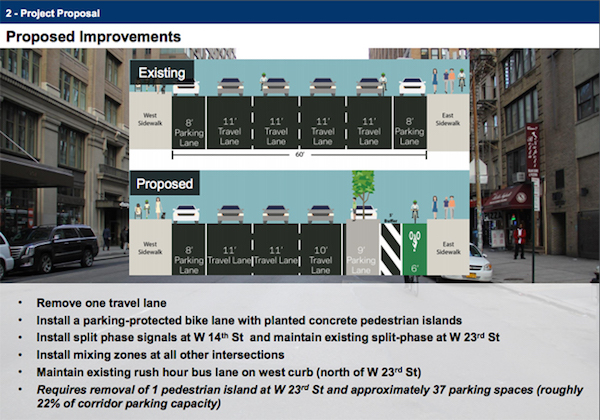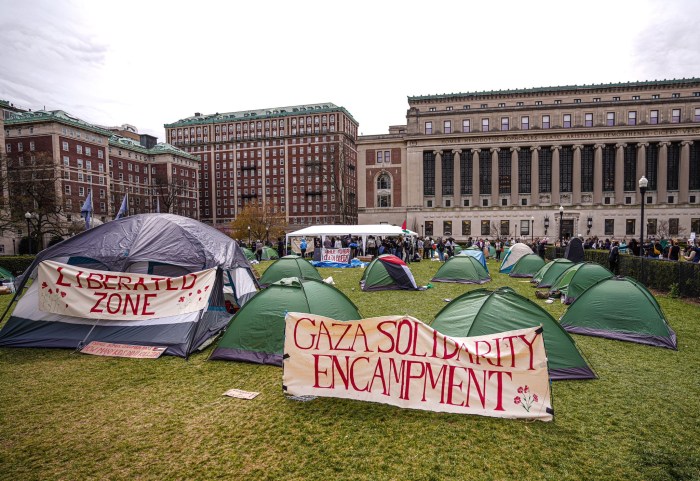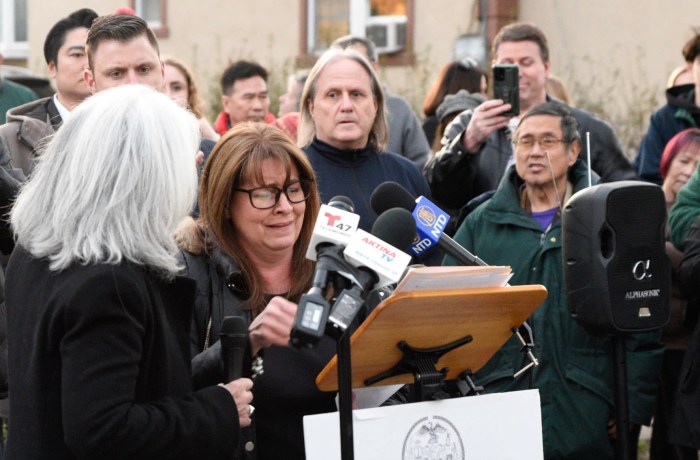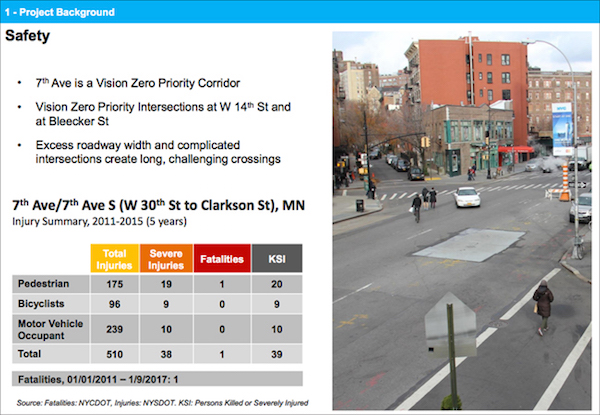
BY DUSICA SUE MALESEVIC | The city announced its plan to install a protected bike lane and other measures along Seventh Ave. — from Clarkson St. to W. 30th St. — after the community and elected officials pushed for a safer corridor.
The bike lane will span the districts of Community Board 2 (CB2) and Community Board 4 (CB4).
Shirley Secunda, chair of CB2’s Traffic and Transportation Committee, said the board had asked for a “complete street” redesign in 2014. Secunda described a complete street as a “whole slew of different improvements for both pedestrians and vehicles as well as bicycles.”
In CB2’s September 2014 resolution, which passed unanimously, the redesign could include “pedestrian safety islands with landscaping, protected bicycle lanes, dedicated bus lanes, and traffic lights with leading pedestrian intervals or split-phase timing.” Elected officials sent letters to the city’s Department of Transportation (DOT) the next year and in 2016. “This was a campaign in action for a long time,” Secunda said.
The DOT presented its plan to CB2’s Traffic and Transportation Committee on Thurs., May 4, and about 50 people showed up, according to Secunda. “I think that for the most part it was very happily [received] and welcomed,” she said in a Sat., May 13 phone interview.
Secunda said that Seventh Ave. below 14th St. (part of which is Seventh Ave. South) has complicated intersections and “as a result every intersection is kind of a nightmare.”
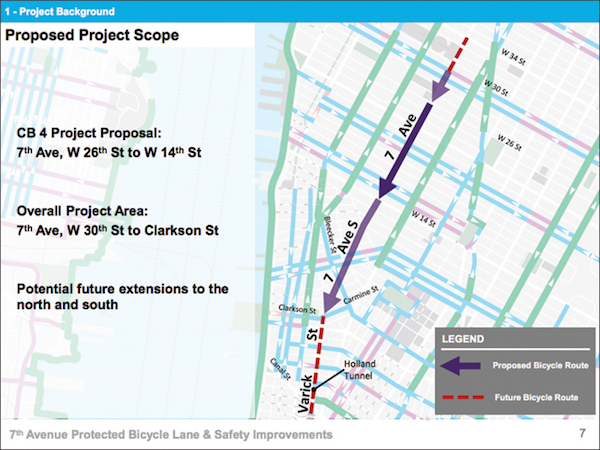
CB2 — like CB4 — is an advocate for split phase signals and there has “always been a problem with left turns,” she said. Currently, many traffic signals at intersections instruct vehicles to turn left at the same time that pedestrians are crossing, Secunda explained. When there is a split phase signal, vehicles are held back by a red light while pedestrians and cyclists can go with a green.
The DOT’s plan is to install split phase signals at some intersections — including Greenwich Ave. and W. 11th St., and W. Fourth St. and Christopher St. — according to the agency’s presentation that was sent to this publication, and Secunda. “That’s a real improvement, that’s very welcome,” she said of the signals.
Split phase signals will also be installed at the W. 14th St. intersection and an existing split phase signal will be maintained at W. 23rd St., according to a CB4 letter to the DOT. The agency presented to CB4’s Transportation Planning Committee (TPC) last month and the protected bike lane was discussed at CB4’s full board meeting on Wed., May 3.
It’s “a standard bike lane,” said Christine Berthet, co-chair of CB4’s TPC. Berthet also helped found Clinton Hell’s Kitchen Coalition for Pedestrian Safety (CHEKPEDS; chekpeds.com).
“The only thing we’d like is to propose there is we have asked for them to do more pedestrian protection and safety items,” Berthet said. In the TPC’s letter to the DOT, it asked “that signals be adjusted to reduce the speed limit so that it does not exceed 25 mph, 24 hours a day” and for split phase signals at all intersections.
Many intersections have what is known as a “mixing zone,” which Berthet called “dangerous.” In a mixing zone, pedestrians, vehicles and cyclist all have a green light, and, as aforementioned, vehicles are turning left as pedestrians are crossing.
CB2’s Secunda said, “It’s proven to be a tremendously vulnerable spot for crashes.” Secunda said she has been in contact with Berthet for years — and that on mixing zones, they are on the same page
From 2011 to 2015, there were nine bicyclists, 10 motor vehicle occupants and 19 pedestrians seriously injured and one pedestrian fatality from Clarkson St. to W. 30th St. on Seventh Ave., according to the DOT. As part of the plan, one lane of traffic will be removed as well as about 50 parking spaces.
The total project cost is estimated at $750,000, Alana Morales, assistant press secretary for the DOT, said in a May 16 email. DOT plans to begin work on the part of the bike lane between Greenwich Ave. and W. 30th St. over the summer, with that stretch slated to be completed at the end of this year, she said. Due to current utility work in the area, DOT plans to begin construction on the section on Seventh Ave. South between Greenwich Ave. and Clarkson St./Carmine St. in 2018, according to Morales.
CB2 also had some tweaks for the agency’s plan — they, too, would like more split phase signals as well as more curb extensions, Secunda said. The committee also asked for a crosswalk to be installed across Seventh Ave. at Leroy St., she said. “It’s really needed there,” she said. “It’s a dangerous spot.”
The committee recommended approval, and the resolution will be presented at the full board meeting of CB2 (nyc.gov/manhattancb2) on Thurs., May 18. CB4 (nyc.gov/mcb4) approved a draft letter that said it was “pleased” with the agency’s plan and that included its “serious concerns about speed, intersection treatments and pedestrian safety.”
The only nay vote was CB4 Chair Delores Rubin, who told Chelsea Now it was a personal position, not a board position that she voted against the bike lane. “The main reason is a good number of cyclists do not follow traffic laws, which means we have a potential conflict with pedestrians and cyclists,” she said. “The bike lanes tend to give the impression there is a separate set of rules for cyclists than other vehicles.”
